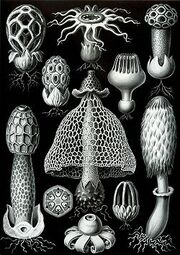
Basidiomycota ( /bəˌsɪdi.ɵmaɪˈkoʊtə/) is one of two large phyla that, together with the Ascomycota, comprise the subkingdom Dikarya (often referred to as the "higher fungi") within the kingdom Fungi. More specifically the Basidiomycota include these groups: mushrooms, puffballs, stinkhorns, bracket fungi, other polypores, jelly fungi, boletes, chanterelles, earth stars, smuts, bunts, rusts, mirror yeasts, and the human pathogenic yeast Cryptococcus. Basically, Basidiomycota are filamentous fungi composed of hyphae (except for yeasts), and reproducing sexually via the formation of specialized club-shaped end cells called basidia that normally bear external meiospores (usually four). These specialized spores are called basidiospores. However, some Basidiomycota reproduce asexually in addition or exclusively. Basidiomycota that reproduce asexually (discussed below) can be recognized as members of this phylum by gross similarity to others, by the formation of a distinctive anatomical feature (the clamp connection - see below), cell wall components, and definitively by phylogenetic molecular analysis of DNA sequence data.